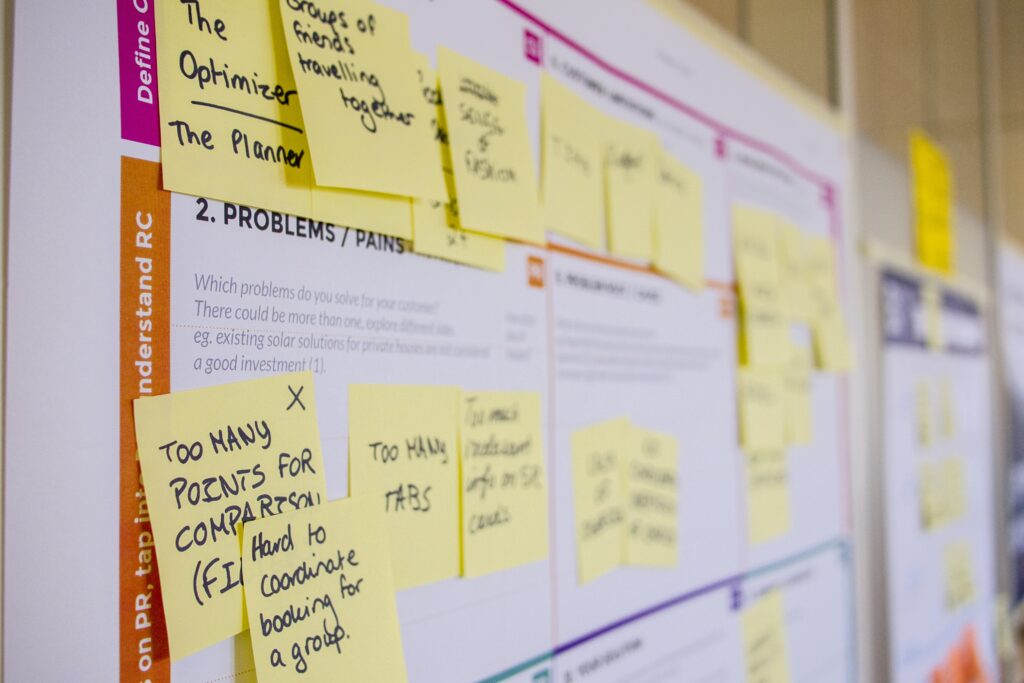The ISO 9001 methodology hinges on two principles: consistent documentation and continual improvement. But what does that mean for businesses working with English language training companies with ISO 9001 certification? This globally recognized standard for quality management systems demonstrates adherence to a number of standard practices that represent a commitment to important values. Those values may be indicators of the quality of service your business can expect when partnering with a language trainer with ISO 9001 certification.
Learn about the benefits of English language learning for companies.
Bridge ISO 9001 certification
Bridge obtained ISO 9001 certification in 2005 as a legal requirement from the Chilean government agency SENCE. Since then, Bridge has maintained its certification every year, undergoing thorough audits conducted by external companies like Bureau Veritas. The certification process ensures consistency between Bridge’s values, mission, quality policies, and course execution and delivery.
“The ISO 9001 certification has had a positive impact on Bridge’s management practices, fostering continuous improvement within the company,” said Carlos Pizarro Navia, Director, BridgeEnglish. “The certification serves as a quality seal that demonstrates Bridge’s commitment to delivering high-quality language education to its clients.”
“International corporations who are Bridge clients recognize the value of the ISO certification and appreciate the assurance it provides. The certification also benefits Bridge partners and other stakeholders by assuring them of the company’s adherence to international quality standards. Being ISO certified reflects Bridge’s dedication to maintaining a strong company culture that prioritizes quality, efficiency, and effective processes.”
Let’s look at what ISO 9001 certification entails, the steps required to meet this standard, and what this certification indicates for customers or partners.
What is an ISO 9001 certification?
At its most basic definition, ISO 9001 is an internationally recognized standard of quality set forth by the International Organization for Standardization (ISO). It specifies requirements for a quality management system, or QMS. This system hinges on systematic documentation, a clear product or service offering, and measurable metrics. The details of this system may vary according to industry as the standard is designed to be tailored to an incredible number of businesses, organizations, and production groups.
Organizations worldwide use the ISO 9001 standard to demonstrate that they are able to consistently deliver a product or service that meets legal and regulatory requirements within their industry.
The International Organization for Standardization
An ISO 9001 certification proves an organization is dedicated to process efficacy and continual improvement in its product or service delivery. Based on an oft-used model for methodology, ISO 9001 requires consistent documentation and numerous audits. Each audit reviews the organizational structure, overall responsibilities, and ongoing procedures within a firm. An ISO certification may also be required by law for some private companies or organizations.
When considering a corporate language partner, ISO 9001 certification indicates a dedication to efficacy and continual improvement. Partners can be confident the language training they receive will meet consistent quality standards, leading to improved learning outcomes. BridgeEnglish has been ISO 9001 certified since 2005, demonstrating a commitment to maintaining high-quality standards in our corporate language programs. Clients can be assured that the quality of Bridge products is consistent each and every time.
Do you regularly audit your language program to ensure efficacy? Learn about best practices in conducting a language training program audit.
What is required to obtain an ISO 9001 certification?
The ISO 9001 certification process can be broken down into five distinct stages. Each step will have varying requirements depending on the size and current operations of the firm. Here we’ll briefly examine the major components of preparing for and applying for an ISO 9001 certification.
For a more in-depth look at each phase of the application process, visit the official website for ISO 9001.

Step 1: Preparing the organization
The first step to getting ISO certified is to ensure every member of the organization understands what is going to happen and how it will affect them. ISO 9001 requires the involvement of all company stakeholders, from executive management at the highest level to all front-facing employees. This preparation not only supports the audit process but has the added benefit of educating all employees on workflow practices and other organizational standard practices.
Identify a representative
Initially, companies typically require a point person throughout the certification process as well. This individual requires training and the necessary resources to ensure that documentation, points of contact, and status updates are provided efficiently. Working with a third party specializing in the certification process can significantly reduce the time spent in preparation as well. Many companies hire a consultant to assist with the certification process.
ISO 9001 is all about streamlining processes, creating efficiency, and quality control. It’s only fitting that the first step to getting certified requires evaluating, planning, and implementing a new internal process for the organization.
Step 2: Gathering documentation
There are four types of documentation that need to be created and approved when preparing for an ISO 9001 certification. Applicants must have a combination of procedures, work instructions, forms and checklists, and process maps. These documents may include company statements for scope and goals, flow charts, records, commonly used forms, formal procedures, and quality control processes.
While documentation is not considered a critical aspect of the certification process, it is nonetheless an important step to observe. ISO focuses on the implementation of planned processes; creating usable and applicable documentation ensures that processes can be integrated and maintained long-term.
Looking for a language training partner? Learn more about how to choose a corporate English training program that fits your company’s needs.
Step 3: Implementing processes
Implementing ISO 9001-standard processes will affect most company employees, from the C-suite to the interns. Implementing change is a challenging subject for any organization. Rolling out modifications in segments is crucial, as is maintaining employee enthusiasm and support. The change processes should simplify workflow, not complicate it. If during implementation flaws are discovered, the team must modify the process and its documentation before re-attempting integration. Each improvement should be efficient, sustainable, and accessible.
When working with an ISO 9001-certified language partner, consider the dedication to quality control this process requires. A company-wide commitment is necessary for meaningful change to occur. A top-down commitment indicates a dedication to improvement that will translate to a consistent and structured approach. The certification process will have many tangential benefits as well. From delivering training modules to assessment methods and evaluations, ISO will have far-reaching effects.
Bridge language partners benefit from a standardized learning experience. This ensures consistency of content delivery and assessment across different trainers and training sessions. These benefits are passed to the customer as efficiency and effectiveness improve.
Investing in management
In this stage of the certification process, leadership invests additional time and resources into their management teams. Training, office hours, Q&A, and open lines of communication are integral parts of assimilating ISO process changes.
Process implementation cannot be rushed, but it should be done efficiently. Routine check-ins and evaluations, consistent record-keeping, and attention to employee feedback complete process implementation in a timely manner.
Common feedback received from Bridge’s corporate language teachers is praise for our simple, consistent, streamlined processes. Kalaivani Pallavanraja, a BridgeEnglish teacher for over two years, describes the system as simple and seamless: “Everything is simple; nothing is complicated. The workflow, navigation, how we are assigned classes, how information about new classes is sent, meeting invitations, back-end support, it’s all a simple process.”
These streamlined processes are a result of investing in management teams and open lines of communication with all stakeholders to identify and rectify any inefficiencies or faulty processes.

Step 4: Conducting an internal audit
Next, companies will evaluate their efficacy and adherence to ISO 9001 requirements. At this stage, all process changes should be implemented and in full swing. The internal audit will be the first major evaluation of the QMS. Process checks throughout implementation will minimize negative feedback, but it’s important to expect some changes to be made to the QMS. Employees act as auditors for this step, using checklists, flowcharts, and other tools provided by the company.
Tailoring the internal audit
The certification process requires a complete audit of the company’s QMS, but it doesn’t require the audit to be completed by the company itself. Many firms opt to hire a third party to conduct this audit as they will have the experience, tools, and personnel trained and ready to review the new workflow.
Larger companies can complete the internal audit in stages, rather than all at once. After the QMS has been audited, any modifications are implemented, then re-audited. Then the company is ready to move to the formal application step.

Learn about best practices for conducting a language training program audit.
Step 5: Applying for certification
Finally, an ISO 9001 certification is awarded after a final independent audit has been completed by a third-party registrar. This individual has a set number of days to conduct their audit and requires one to two months of records to prove the effective implementation of a company’s QMS. They conduct a two-phase audit, first reviewing all relevant documentation and processes. Next, they closely examine daily operations to verify the processes have been effectively implemented and are being maintained.
Most organizations get hit with a few infractions at this stage, but once the corrections are addressed, a formal ISO 9001 certification is awarded and remains valid for three years.
Why is ISO 9001 certification an industry standard?
The ISO 9001 certification program has been used globally since 1980 when the first standardization committee convened to make modifications to the previous iteration of the program. The first edition of ISO 9001 was published in 1987 and has continued to evolve as technological advances and global markets shift. ISO 9001 certification is an industry standard because it is incredibly well-rounded and can be applied to various businesses and organizations. The certification requires a focus on satisfied customers, leadership, and employees while emphasizing continual process improvement. The ISO 9001 certification requires the creation and implementation of an organized QMS, which often creates significant cost savings if successfully integrated.
Quality assurance
It’s important that clients are assured that the products and services they invest in are high quality, and ISO 9001 Certification provides that assurance with a framework for companies to regularly assess all aspects of their business through a systematic, documented process. Language program partners can have confidence in the quality of the services provided by Bridge because we are required to adhere to a well-established and approved ISO 9001 framework for quality assurance. This certification builds trust between our brand and our partners.
Consistent training standards
An ISO 9001 certification ensures companies follow consistent and standardized processes in their training. For Bridge, this creates consistency in the delivery of our language training programs. This means clients can expect uniformity in the delivery of training across different courses and trainers. Bridge trainers are provided free access to personalized professional development plans that include our suite of TEFL/TESOL certifications and micro-credentials. Classroom observations and mentorship are also part of the continuing professional development provided to Bridge teachers.
Investment in ISO 9001 certification provides regular documentation of our training processes to confirm their effectiveness and to track their impact on course delivery to our language partners, with the end goal being to ensure quality learning experiences for students with a seamless integration for HR and leadership teams. Bridge provides clients with a reliable and transparent learning environment with success rates backed by empirical data.
Continuous improvement
ISO 9001 emphasizes the concept of continuous improvement. This concept requires a company to constantly assess, upgrade, modify, and enhance its product and production processes. For Bridge, this means continually evaluating, updating, and improving our language training programs. Bridge focuses on both the macro and micro experiences. This is done by gathering client feedback from management teams while also continually monitoring student data and performance metrics. A key component to successful continuous improvement is to implement corrective actions to address identified areas of concern. Bridge language partners benefit from a language program that is regularly reviewed and optimized to meet evolving needs and industry best practices.
Customer satisfaction
In many ways, the customer is always right, and this is especially true for ISO 9001-certified companies. ISO requires a strong focus on the customer experience and rates customer satisfaction as one of the leading indicators of effective change. Bridge works to go above and beyond this requirement by exceeding client expectations. By implementing customer feedback mechanisms and maintaining effective communication channels, Bridge can ensure clients’ needs are understood and addressed promptly. This customer-centric approach leads to higher client satisfaction and a positive overall learning experience.
Find out how Bridge’s language programs provide customized learning paths.
International recognition
Lastly, the ISO 9001 certification is only valid for three years. In order to maintain this certification, companies must submit to routine audits and update their process documentation accordingly. Consumers and stakeholders trust this certification because it is not a one-and-done seal of approval; companies must continually strive for efficiency and improvement. Bridge has maintained this certification since 2005, undergoing thorough audits conducted by external companies such as Bureau Veritas. This commitment to full compliance and efficient implementation of improvements to the QMS reflects Bridge’s dedication to ensuring the continuous quality of services and products.










